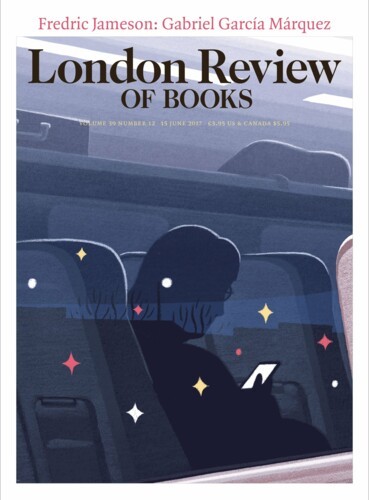It is almost the inverse of the Disney parks where you pay to have a prepared experience offered to you. At Ghibli you are left to make your own experience, playing out your memories of favourite films or scenes.
Rosemary Hill
Rosemary Hill’s most recent book is Time’s Witness: History in the Age of Romanticism. Her four-part series, The Lives of Stonehenge, can be found on the LRB Podcast. She is a contributing editor at the LRB.
The first time I remember meeting Carmen was at a London Review Christmas party. She came up to me and said: ‘You’re marvellous darling, you understand irony.’ I’m not sure whether she actually poked me in the chest but I felt as if she had. Then she moved off without further comment.
Battersea Arts Centre, badly damaged by a fire last Friday, started life as the town hall. In the spirit of late Victorian civic pride and aspiration, the capacious porch is decorated with figures representing Labour, Progress, Art and Literature instructing the infant Battersea, who looks remarkably confident about the likely benefits coming his way. Built in 1892-93 to the designs of E.W. Mountford (the architect of the Old Bailey), the imposing exterior anticipates Edwardian Baroque while the interior is tinged with the dawning of art nouveau, most strikingly in the great coloured glass dome, painted with tendrils of golden foliage, like a giant Tiffany lampshade.
Chris Larner’s comedy The Frida Kahlo of Penge West had its first performance last June at the Rosemary Branch Theatre in Islington, where the mere mention of Penge no doubt guaranteed a quick, if cheap laugh. All the braver of him then to take the play into the lion’s mouth by putting it on at the Bridge House Theatre in Penge High Street, that defiantly hipster-free part of southeast London where, as one of his characters puts it, ‘London was sick over Kent.’
There is nothing obviously odd about the generic military-man-on-a-horse partly visible through the nearly leafless trees in Cavendish Square. He is William, Duke of Cumberland (1721-65), and the plinth would lead you to believe his statue has been there since 1770. It hasn’t.
Podcasts & Videos
The Lives of Stonehenge: John Michell and Arthur Pendragon
Jeremy Harte and Rosemary Hill
Rosemary Hill and Jeremy Harte discuss the many groups and stories that have emerged throughout the 20th century to challenge the narratives about Stonehenge presented by archaeologists.
The Lives of Stonehenge: Wordsworth and Blake
Seamus Perry and Rosemary Hill
For the third episode in her short series on Stonehenge, Rosemary Hill is joined by Seamus Perry to experience the stone circle through the mind and eyes of a Romantic, with the likes of Wordsworth, Blake,...
The Lives of Stonehenge: John Aubrey and William Stukeley
Rosemary Hill and Kate Bennett
In the second episode of her short series looking at why Stonehenge has occupied such an important place in the story of Britain, Rosemary Hill talks to Kate Bennett about the two antiquarians, John Aubrey...
The Lives of Stonehenge: Inigo Jones and John Wood
Rosemary Hill and Vaughan Hart
Rosemary Hill begins a new four-part series looking at what people have thought about Stonehenge over the past few hundred years, and why it’s come to matter so much in the story of Britain. In the first...
Romantic History: Waterloo to the British Museum
Neil MacGregor and Rosemary Hill
In the final episode in our series looking at the way history was transformed in the Romantic period, Neil MacGregor joins Rosemary Hill to discuss the circulation of artefacts throughout Europe in the...
Romantic History: The Bayeux Tapestry
Rosemary Hill and Roey Sweet
In the third episode of her series looking at how history was transformed in the Romantic period, Rosemary Hill talks to Roey Sweet about the antiquarians, a new breed of multi-disciplinary investigators,...
Romantic History: Balmoral
Rosemary Hill and Colin Kidd
In the 1740s the Scots were invading England and the wearing of tartan was banned. By the 1850s, Queen Victoria had built her Gothic fantasy in Aberdeenshire and tartan was everywhere. What happened in...
Romantic History: Salisbury Cathedral
Rosemary Hill and Tom Stammers
In the first episode of a new four-part series looking at the way history was transformed in the Romantic period, Rosemary Hill is joined by Tom Stammers to consider how an argument over the ‘improvement’...
What does she think she looks like?
Rosemary Hill
Rosemary Hill looks at women and clothes, and what happens between them, in life and literature, in her 2018 LRB Winter Lecture.
Pieces about Rosemary Hill in the LRB
Leave me my illusions: Antiquarianism
Nicholas Penny, 29 July 2021
Moonlight on broken stone tracery is a common motif; dark interiors provide a foil for stained glass and for white satin and deep blue velvet. The men must be away on the crusades. Young women are sobbing...
Very Pointed: Pugin
Dinah Birch, 20 September 2007
Modern lives look prim beside the turbulent existence of Augustus Welby Northmore Pugin. Distractions and misfortunes proliferated throughout his career: shipwreck (he was in his own boat,...
Read anywhere with the London Review of Books app, available now from the App Store for Apple devices, Google Play for Android devices and Amazon for your Kindle Fire.
Sign up to our newsletter
For highlights from the latest issue, our archive and the blog, as well as news, events and exclusive promotions.

